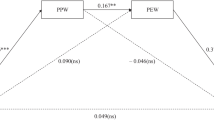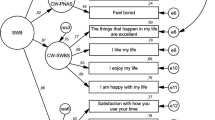Abstract
This paper examines the relative influence of family stressors and the family’s socioeconomic circumstances on children’s happiness. Data from the 9 year old cohort of the national Growing Up in Ireland study (GUI) was used to examine these relationships. The sample consisted of 8,568 children and their families. The stressors considered were a conflictual parent–child relationship; children with emotional and social problems; parental depression; low parental self-efficacy and child isolation. A group of families and children who were experiencing a higher level of these stressors was identified. This constituted 16 % of the sample. Although socioeconomic disadvantage contributed significantly to the vulnerability of this group, it was by no means the sole or dominant issue. Using the Piers-Harris Happiness and Satisfaction Subscale, children’s self-assessed happiness in this identified group was found to be significantly lower than in the other groups, irrespective of socioeconomic and demographic variables. The family stressors were found to explain more than twice the variance in the children’s happiness than explained by the measures of socioeconomic status. Nonetheless, most of the variance remains unexplained. Future research directions to explore this are indicated.



Similar content being viewed by others
References
Aldgate, J. (2006). Children, development and ecology. In J. Aldgate, D. P. H. Jones, W. Rose, & C. Jeffrey (Eds.), The developing world of the child. London: Jessica Kingsley Publishers.
Aldgate, J. (2010). Child well-being, child development and family life. In C. McAuley & W. Rose (Eds.), Child well-being: understanding children’s lives (pp. 21–38). London: Jessica Kingsley Publishers.
Ash, C., & Heubner, E. S. (2002). Environmental events and life satisfaction reports of adolescents: a test of cognition mediation. School Psychology International, 22, 320–336.
Ben-Arieh, A. (2005). Where are the children? Children’s role in measuring and monitoring their well-being. Social Indicators, 74(3), 573–596.
Ben-Arieh, A. (2008). The child indicators movement: past, present and future. Child Indicators Research, 1, 3–16.
Ben-Arieh, A. (2010). Developing indicators for child well-being in a changing context. In C. McAuley & W. Rose (Eds.), Child well-being: understanding children’s lives (pp. 129–142). London: Jessica Kingsley Publishers.
Blackman, I., Cromby, J., Hook, D., Papadopoulos, D., & Walkerdine, V. (2008). Creating subjectivities editorial. Subjectivity, 22, 1–27.
Bradshaw, J. (1990). Child poverty and deprivation in the UK. London: National Children’s Bureau.
Bronfenbrenner, U. (1979). The ecology of human development: experiment by nature and design. Cambridge: Harvard University Press.
Bronfenbrenner, U., & Morris, P. (2006). The bioecological model of human development. In W. Damon & R. Lerner (Eds.), Handbook of child psychology. NJ. Sixth Edition. John Wiley and Sons.
Burton, P., & Phipps, S. (2008). From a young teen’s perspective: income and happiness of Canadian 12–15 year olds. Canada: Dalhousie University. Working Paper 2008–04.
Byrne, B. (1996). Measuring self-concept across the life span: issues and instrumentation. Washington, DC: American Psychological Association.
Campbell, A., Converse, P., & Rogers, W. (1976). The quality of American life: perceptions, evaluations and satisfactions. Nueva York: Russell Sage.
Casas, F. (2011). Subjective social indicators and child and adolescent well-being. Child Indicators, 4, 555–575.
Chaplain, L. N. (2009). Please may I have a bike? Better yet, may I have a hug? An examination of children’s and adolescent’s happiness. Journal of Happiness Studies, 10, 541–562.
Cheng, H., & Furnham, A. (2003). Personality, self-esteem and demographic predictions of happiness and depression. Personality and Individual Differences, 34, 921–942.
Conger, R. D., Conger, K. J., Elder, G. H., Lorenz, F. O., Simons, R. L., & Whitbeck, L. B. (1992). A family process model of economic hardship and adjustment of early adolescent boys. Child Development, 63, 526–541.
Conger, R. D., Ge, X., Elder, G. H., Lorenz, F. O., & Simons, R. L. (1994). Economic stress, coercive family process and developmental problems in adolescents. Child Development, 65, 541–561.
Counterpoint. (2008). Childhood wellbeing: qualitative research study. London: DCSF.
Diener, E., & Lucas, R. (1999). Personality and subjective well-being. In D. Kahneman, E. Diener, & N. Schwartz (Eds.), Well-being: the foundations of hedonic psychology (pp. 213–229). New York: Russell Sage.
Elder, G., Nguyen, T., & Capsi, A. (1985). Linking family hardships to children’s life. Child Development, 56, 361–375.
Ereaut, G., & Whiting, R. (2008). What do we mean by ‘wellbeing’? And why might it matter? Research Report DCSF-RWO73. London: Department for Children, Schools and Families.
Fattore, T., Mason, J., & Watson, E. (2009). When children are asked about their well-being: towards a framework for guiding policy. Child Indicators Research, 2(1), 57–77.
Goerge, R. M. (1997). The use of administrative data in measuring the state of children. In A. Ben-Arieh & H. Wintersberger (Eds.), Monitoring and measuring the state of children: beyond survival (pp. 277–286). Vienna: European Centre for Social Welfare Policy and Research. Eurosocial Report no 62.
Goodman, R. (1997). The strengths and difficulties questionnaire: a research note. Journal of Child Psychology and Psychiatry, 38, 581–586.
Goodman, R., Ford, T., Simmons, H., Gatward, R., & Meltzer, H. (2000). Using the strengths and difficulties questionnaire (SDQ) to screen for child psychiatric disorders in a community sample. The British Journal of Psychiatry, 177, 534–539.
Goodman, S. H., & Gotlib, I. H. (Eds.). (2002). Children of depressed parents: mechanisms of risk and implications for treatment. Washington, DC: APA.
Goswami, H. (2011). Social relationships and children’s subjective well-being. Social Indicators Research.
Gurin, G., Veroff, J., & Feld, S. (1960). Americans views of their mental health. New York: Basic Books.
Hoff, E., Laursen, B., & Tardif, T. (2002). Socioeconomic status and parenting. In M. H. Bornstein (Ed.), Handbook of parenting. Volume 2. Biology and ecology of parenting (2nd ed., pp. 231–252). Mahwah: Lawrence Erlbaum & Associates.
Holder, M. D., & Coleman, B. (2009). The contribution of social relationships to children’s happiness. Journal of Happiness Studies, 10, 329–349.
Holder, M. D., & Klassen, A. (2010). Temperament and happiness in children. Journal of Happiness Studies, 11, 419–439.
Huebner, E. S. (2004). Research on assessment of life satisfaction of children and adolescents. Social Indicators Research, 66(1–2), 3–33.
Jones, T. L., & Prinz, R. J. (2005). Potential roles of parental self-efficacy in parent and child adjustment: a review. Clinical Psychology Review, 25(3), 341–363.
Layard, R., & Dunn, J. (2009). A good childhood. London: Penguin.
Lo, Y., Mendell, N. R., & Rubin, D. B. (2001). Testing the number of components in a normal mixture. Biometrika, 88, 767–778.
Lobstein, T., & Frelut, M. L. (2003). Prevalence of overweight among children in Europe. Obesity Reviews, 4, 195–200.
Lovejoy, M. C., Graczyk, P. A., O’Hare, E., & Neuman, G. (2000). Maternal depression and parenting: a meta-analytic review. Clinical Psychology Review, 20, 561–592.
Lyubomirsky, S., King, L., & Deiner, E. (2005). The benefits of frequent positive affect: does happiness lead to success? Psychological Bulletin, 131, 803–855.
Marsh, H. W., & Holmes, I. W. (1990). Multidimensional self-concepts: construct validation of responses by children. American Educational Research Journal, 27, 89–117.
McAuley, C., McCurry, N., Knapp, M., Beecham, J., & Sleed, M. (2006). Young families under stress: assessing maternal and child well-being using a mixed methods approach. Child and Family Social Work, 11, 43–54.
McAuley, C., Morgan, R., & Rose, W. (2010). Children’s views on child well-being. In C. McAuley & W. Rose (Eds.), Child well-being: understanding children’s lives (pp. 39–66). London: Jessica Kingsley Publishers.
McAuley, C., & Rose, W. (Eds.). (2010a). Child well-being: understanding children’s lives. London: Jessica Kingsley Publishers.
McAuley, C., & Rose, W. (2010b). Child well-being: Current issues and future directions. In C. McAuley & W. Rose (Eds.), Child well-being: understanding children’s lives (pp. 207–218). London: Jessica Kingsley Publishers.
McAuley, C., & Rose, W. (in press). Social and emotional relationships and children’s well-being: The views of children on families and friends. In A. Ben-Arieh, F. Casas, I. Frones and J. Korbin (Eds.), Handbook of child well-being. Dordrecht: Springer.
Patterson, G. R., Reid, J. B., & Dishion, T. J. (1992). Antisocial boys: a social-interactional approach. Eugene: Castilia Press.
Pianta, R. C. (1992) Child-parent relationship scale. Unpublished measure, Charlottesville: University of Virginia.
Piers, E. V., & Harris, D. B. (1984). Piers-Harris children’s self-concept scale. Los Angeles: Western Psychological Services.
Piers, E. V., & Herzberg, D. S. (2002). Manual for the Piers-Harris children’s self-concept scale (2nd ed.). Los Angeles: Western Psychological Services.
Pollard, E., & Lee, P. L. (2003). Child well-being: a systematic review of the literature. Social Indicators Research, 61, 59–78.
Prout, A., & James, A. (Eds.). (1990). Constructing and reconstructing childhood: contemporary issues in the sociological study of childhood. London: Falmer Press.
Pryor, J., & Rodgers, B. (2001). Children in changing families: life after parental separation. Oxford: Blackwell.
Pugh, G. (2010). Foreword. In C. McAuley & W. Rose (Eds.), Child well-being: understanding children’s lives. London: Jessica Kingsley.
Radloff, L. S. (1977). The CES-D scale: a self-report depression scale for research in the general population. Applied Psychological Measurement, 1, 385–401.
Radziszewska, B., Richardson, J. L., Dent, C. W., & Flay, B. R. (1996). Parenting styles and adolescent depressive symptoms, smoking and academic achievement: ethnic, gender and sex differences. Journal of Behavioural Medicine, 19, 289–305.
Royston, P. (2004). Multiple imputation of missing values. Stata Journal, 4, 227–241.
Tangney, J.P, & Feshbach, N.D. (1987). Some implications of maternal employment for the mother and the family. Paper presented at the Conference on Women at Work. Los Angeles, CA.
Teti, D., & Candelaria, M. A. (2002). Parenting competence. In M. H. Bornstein (Ed.), Handbook of parenting. Vol.4: social conditions and applied parenting (pp. 149–180). New Jersey: Lawrence Erlbaum Associates.
Thoilliez, B. (2011). How to grow up happy: an exploratory study on the meaning of happiness from children’s voices. Child Indicators Research, 4, 323–351.
UNICEF. (2007). Child poverty in perspective: an overview of child well-being in rich countries. Florence: UNICEF. Innocenti Report Card 7.
UNICEF. (2011). Children’s well-being in the UK, Sweden and Spain; the role of inequality and materialism. Florence: UNICEF.
United Nations (1989). UN convention on the rights of the child. Geneva: United Nations.
Vig, D., & Jaswal, I. J. S. (2008). Impact of parental stress on their relationship with teenage children. Studies on Home and Community Science, 2(1), 51–57.
Webster-Stratton, C. (1990). Stress: a potential disruptor of parental perception and family interactions. Journal of Clinical Child Psychology, 19(4), 302–312.
Young, R. M., & Bradley, M. T. (1998). Social withdrawal: self-efficacy, happiness and popularity in introverted and extraverted adolescents. Canadian Journal of School Psychology, 14, 21–35.
Author information
Authors and Affiliations
Corresponding author
Rights and permissions
About this article
Cite this article
McAuley, C., Layte, R. Exploring the Relative Influence of Family Stressors and Socio-Economic Context on Children’s Happiness and Well-Being. Child Ind Res 5, 523–545 (2012). https://doi.org/10.1007/s12187-012-9153-7
Accepted:
Published:
Issue Date:
DOI: https://doi.org/10.1007/s12187-012-9153-7




